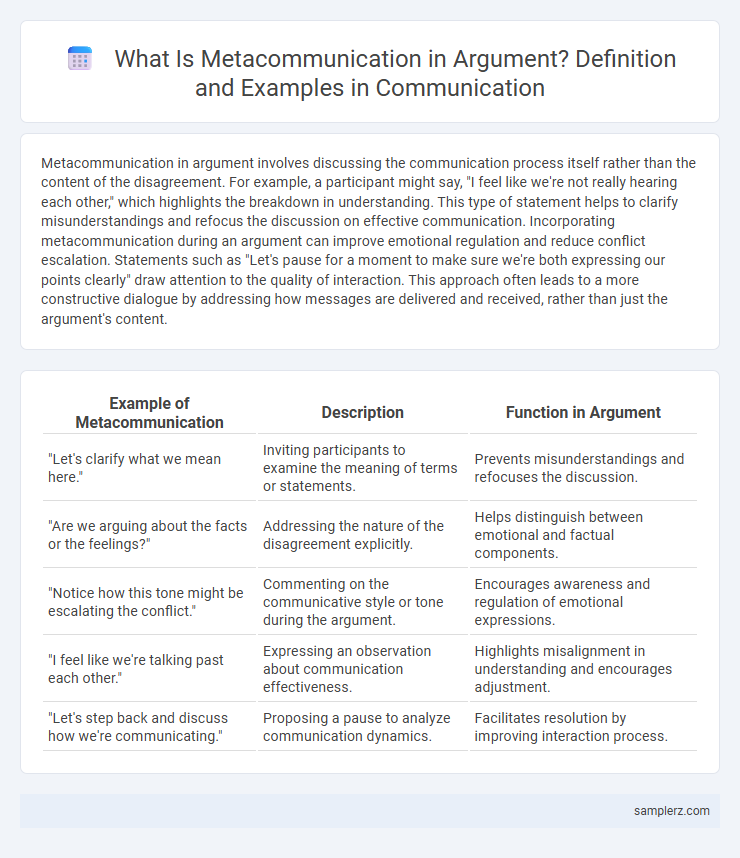Metacommunication in argument involves discussing the communication process itself rather than the content of the disagreement. For example, a participant might say, "I feel like we're not really hearing each other," which highlights the breakdown in understanding. This type of statement helps to clarify misunderstandings and refocus the discussion on effective communication. Incorporating metacommunication during an argument can improve emotional regulation and reduce conflict escalation. Statements such as "Let's pause for a moment to make sure we're both expressing our points clearly" draw attention to the quality of interaction. This approach often leads to a more constructive dialogue by addressing how messages are delivered and received, rather than just the argument's content.
Table of Comparison
| Example of Metacommunication | Description | Function in Argument |
|---|---|---|
| "Let's clarify what we mean here." | Inviting participants to examine the meaning of terms or statements. | Prevents misunderstandings and refocuses the discussion. |
| "Are we arguing about the facts or the feelings?" | Addressing the nature of the disagreement explicitly. | Helps distinguish between emotional and factual components. |
| "Notice how this tone might be escalating the conflict." | Commenting on the communicative style or tone during the argument. | Encourages awareness and regulation of emotional expressions. |
| "I feel like we're talking past each other." | Expressing an observation about communication effectiveness. | Highlights misalignment in understanding and encourages adjustment. |
| "Let's step back and discuss how we're communicating." | Proposing a pause to analyze communication dynamics. | Facilitates resolution by improving interaction process. |
Understanding Metacommunication in Arguments
Metacommunication in arguments involves discussing the process of the argument itself, such as clarifying the tone or intent behind statements to avoid misunderstandings. For example, saying "Let's focus on the issue, not the emotions" signals awareness of emotional escalation and redirects the conversation. This approach enhances mutual understanding and helps de-escalate conflicts by addressing how communication occurs rather than just the content.
The Role of Metacommunication During Disagreements
Metacommunication plays a crucial role during disagreements by allowing participants to address not just the content of the argument but also the underlying emotions and intentions. For example, stating "I feel like we're misunderstanding each other" redirects focus from conflict to clarification, reducing escalation. This layer of communication facilitates empathy and mutual understanding, ultimately improving conflict resolution outcomes.
Common Examples of Metacommunication in Conflict
In conflicts, a common example of metacommunication is when individuals discuss the way they are communicating instead of the content of the disagreement, such as saying, "Let's pause and talk about how we're arguing." Nonverbal cues like tone of voice, facial expressions, and body language often serve as metacommunicative signals that reflect underlying emotions and impact the conflict's intensity. Clarifying intentions and feelings through metacommunication helps prevent misunderstandings and fosters more constructive resolution.
Nonverbal Metacommunication Signals in Arguments
Nonverbal metacommunication signals in arguments include facial expressions such as frowns or raised eyebrows that indicate frustration or disbelief, and gestures like crossed arms signaling defensiveness. Eye contact patterns, such as avoiding or sustained eye contact, often reveal underlying emotions and the level of engagement in the dispute. Tone of voice, including pitch and volume changes, serves as a metacommunicative cue that can either escalate or de-escalate tensions during an argument.
How Tone of Voice Influences Argument Metacommunication
Tone of voice plays a crucial role in argument metacommunication by conveying emotions and attitudes beyond the literal meaning of words, often signaling respect, sarcasm, or hostility. Changes in pitch, volume, and pace can either escalate tensions or facilitate understanding by modifying how messages are received and interpreted. Effective use of tone of voice helps manage the emotional climate of an argument, promoting clarity and reducing miscommunication.
Clarifying Intentions Through Metacommunication
In arguments, metacommunication clarifies intentions by explicitly stating the purpose behind statements, such as saying, "I'm trying to understand your perspective, not attack you." This approach helps prevent misunderstandings by focusing on the speaker's feelings or goals rather than the content alone. Effective use of metacommunication fosters respectful dialogue and reduces defensive reactions during conflicts.
Impact of Body Language in Argument Contexts
Body language significantly influences argument outcomes by conveying emotions and attitudes beyond spoken words, such as crossed arms signaling defensiveness or consistent eye contact indicating confidence. Nonverbal cues like facial expressions and posture can either escalate tension or facilitate resolution by affecting the perceived sincerity and openness of the interlocutor. Understanding these metacommunicative signals enhances communication effectiveness and helps prevent misunderstandings during conflicts.
Metacommunication Phrases That Diffuse Tension
Metacommunication phrases such as "Let's take a step back and understand each other's perspective" and "I hear your point, and I want to clarify mine" effectively diffuse tension in arguments by promoting mutual understanding. Expressing feelings with statements like "I feel frustrated when my points are interrupted" helps to shift the focus from conflict to constructive dialogue. These metacommunication strategies create a safer communication environment that fosters resolution and collaboration.
Misinterpretations of Metacommunication in Arguments
Misinterpretations of metacommunication in arguments often occur when tone, body language, or implied meanings are misunderstood, leading to escalated conflicts. For example, sarcasm or a defensive posture can be interpreted as hostility rather than a call for clarification, distorting the original message. Effective communication requires recognizing these cues and explicitly addressing them to prevent misunderstandings and resolve disputes constructively.
Strategies to Improve Metacommunication When Arguing
Using "I" statements and clarifying intentions during an argument helps reduce misunderstandings and promotes openness. Pausing to reflect on emotional tone and nonverbal cues enables both parties to recognize underlying feelings beyond spoken words. Establishing rules for respectful dialogue and checking for shared interpretations ensures arguments remain constructive and focused on resolution.

example of metacommunication in argument Infographic
 samplerz.com
samplerz.com